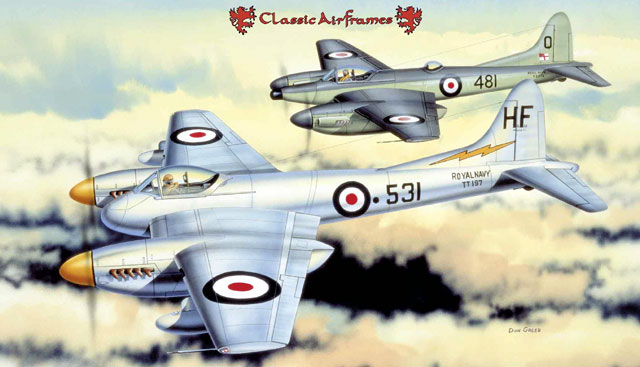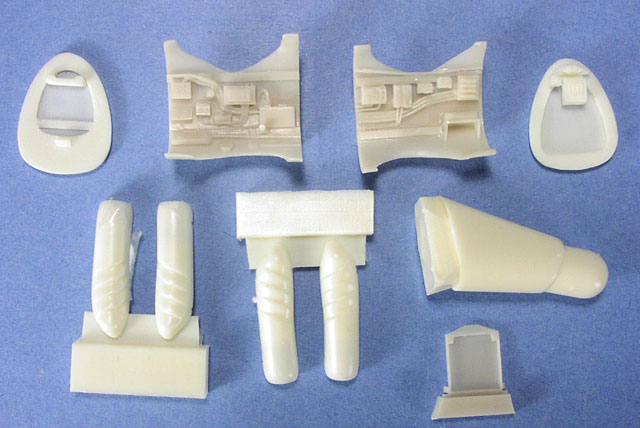|
DeHavilland Hornet /
Sea Hornet

Classic Airframes
S
u m m a r y
|
| Catalogue Number
: |
459 (Sea Hornet)
458 (Hornet) |
| Scale: |
1/48 |
| Price: |
Sea Hornet: USD$60.00 RRP
Hornet: USD$55.00 RRP |
| Contents and Media: |
Low-pressure injection plastic - 63
grey styrene and 2 each clear vacform canopy, rear canopy, fuselage side
windows and access door window. 41 parts in pale cream-colored resin.
Instructions, decal sheet and painting guide for 2 aircraft. (Contents
list applies to the Sea Hornet) |
| Review Type: |
FirstLook |
| Advantages: |
The first injection molded 1/48
scale kit of the RAF’s last piston-engine fighter to see active combat.
Probably CA’s finest kit to date, with beautifully engraved panel lines
and raised reinforcing strap around the fuselage. Keyed prop blades. Full
resin rear observer / radar operator’s cockpit. Well designated cutouts
for the rear cockpit opening, rear access door, and fuselage windows.
|
| Disadvantages: |
Poorly engineered sprue gate at
inner trailing edge of lower wing caused some damage. Exhaust stub broken
off in transit. |
| Recommendation: |
Highly Recommended for moderate to
experienced modelers who enjoy modeling the less well known aircraft of
the post-WW-2 era. |
Reviewed by Steven Eisenman

Classic Airframes' 1/48 scale Hornet and Sea Hornet kits
are available online from Squadron.com
Special Note
While many kit maker will acknowledge the help of
various individuals, I am pleased to note that Classic Airframes has dedicated
the Hornet/Sea Hornet kit to Mr. Derek Pennington in recognition of not only his
help in developing the kit, but also in recognition of his personal involvement
with Hornets whilst in service to Queen and Country in the Far East.
Usually referred to as the worthy successor to the de Havilland Mosquito, the
Hornet was probably one of the best looking piston-engine fighters developed.
After the successful introduction of the Mossie, de Havilland began work on the
jet-engine Vampire. But, not wanting to put all its eggs into one basket, de
Havilland responded to the Air Ministry’s request for a high speed, twin engine,
unarmed night bomber. But due to the lack of Sabre engines, the project was
terminated.
De Havilland continued to privately work on a scaled down version of the
Mosquito using the small profile Merlin engine with the intended purpose being a
long-range fighter for the Pacific theatre. Even though the prototype was
developed in 1943, the Hornet did not see action in WW-2. It was not until 1955
that the Hornet was removed from combat, nearly a decade after it was first
assigned to Number 64 Squadron.

The Hornet, while resembling the Mossie, was a completely new design. It was
that design that allowed to Hornet to play a variety of roles: High-speed
interceptor, long-range escort fighter, and long-range, low level intruder. When
the Royal Navy was desperately in need of new carrier based fighter aircraft,
the Hornet’s design made it a logical choice. With its powerful Merlin engines
turning four bladed props in opposite directions (rotation towards the
aircraft’s centerline), the Hornet was fitted with folding wings, a tail hook
and strengthened fuselage.
Whilst I have the Sea Hornet kit, it seems that it uses the same injection
moldings and main cockpit resin as the basic Hornet Kit. The difference is that
the Sea Hornet kits comes with an additional package of resin and rear canopy to
be used for the NF.21 night-fighter version.

This extra package includes a full rear observer/radar operator’s cockpit and
bulkheads. Also included in the package is the thimble-dome radar replacement
nose and the exhaust shrouds. The arrestor hook and the rear cockpit access door
are on the injection molded sprues.
Regardless of the kit you get, you have the option to depict either the early or
late style fin and rudder and horizontal tail planes. Also, whilst the kit does
not include any ordnance, it does include two resin bomb racks and four
injection molded rocket rails. This appears to be the standard ordnance
configuration on both the Hornet and Sea Hornet.
Click the thumbnails below to view
larger images:
Construction appears to be very straight forward. You will, however, need to
remove a fair number of injection molding stubs on the inner surfaces of all the
major components of the kit. This is not a real problem but a chisel blade will
be of great help. The propeller blades are handed, so you will need to pay
attention when assembling the props. Thoughtfully, they are keyed so setting the
proper pitch will not be much of a problem.
One of the first things you will need to do is the fuselage cut outs. The first
one, and applicable to all version, is to cut out the lower nose for the resin
gun package. Luckily the cuts needed for this are to be made along clearly
marked panel lines. Although the instructions show the cut being made after the
fuselage is together, I would recommend doing it as a first task. You will also
need to open the side fuselage ports, as applicable.

Finally, if you are doing the night-fighter (as I plan to do) you need to cut
off the nose and open up the rear cockpit, and lower access door.
The instruction sheet is well laid out and clearly show what parts and work will
be required to make each of the four Hornet/Sea Hornet variants.
Markings are included for two Sea Hornets. The first, a silver doped F.20 of 728
Squadron, FAA, at Hal Far, Malta in 1954 (Note: The Hornet was wood, so it is
not a natural metal finish). The second is a FAA NF.21 night-fighter in Extra
dark Sea Gray over Sky, which was assigned to 809 Squadron on HMS Vengeance in
1951.
For the Hornet kit (No. 458), there are also marking for two aircraft. The first
is for a silver doped early style F.1 assigned to Sqn. Ldr. Haw of No. 65
Squadron, Linton-on-Ouse, 1947. This aircraft has bright red chevrons on the
fuselage and wing-tops. The second is an F.3 in Dark Green, Dark Sea Gray with
PRU undersides and a silver rudder. This aircraft served with No. 80 Squadron at
Kai Tak, Hong Kong in 1954.
Click the thumbnails below to view
larger images:
No question about it, you don’t have to be one of Her Majesty’s Subjects to
appreciate this great looking aircraft. And whilst the instruction are quite
explicit in stating that the kit is for experienced modelers, I believe the term
experienced can be given a bit of latitude. Just take your time in making the
necessary cuts, and even a “less experienced” modeler will be rewarded with a
fine model.
If you are at all interested in the Hornet/Sea Hornet, I would recommend that
you get Warpaint Series No. 19; de Havilland Hornet by Tony Butler.
Thanks to Jules Bringuier of Classic
Airframes for the review sample.
Classic
Airframes kits are available worldwide through hobby retailers and at
Squadron.com
Review Text and Images Copyright © 2002 by
Steven Eisenman
Page Created 06 January, 2003
Last updated 22 July, 2003
Back to HyperScale
Main Page
Back to Reviews
Page
|
Home | What's
New | Features
| Gallery |
Reviews | Reference
| Forum
| Search